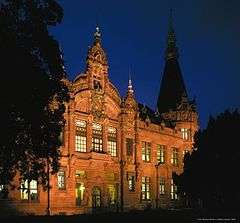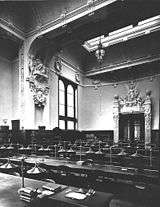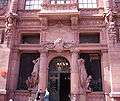Heidelberg University Library
 The main building, built in 1905 | |
| Established | 1388 |
|---|---|
| Location | Heidelberg |
| Coordinates |
49°25′04″N 8°40′06″E / 49.41774°N 8.66834°E 49°24′35″N 8°42′21″E / 49.40973°N 8.70586°E |
| Branches | 2 (Neuenheimer Feld, Plöck) |
| Collection | |
| Size | 3,200,000 books |
| Access and use | |
| Circulation | 1,600,000 books |
| Population served | general public |
| Members | 38,000 |
| Other information | |
| Director | Dr. Veit Probst |
| Staff | 177 |
| Website | http://ub.uni-heidelberg.de |
The University Library Heidelberg (German: Universitätsbibliothek Heidelberg) is the central library of the University of Heidelberg. It constitutes together with the 83 decentralized libraries of the faculties and institutes the University Library System, which is headed by the director of the University Library. The University Library holds special collections in literature concerning the Palatinate and Baden, egyptology, archeology, the history of art, and South Asia. It holds about 3.2 million books, 10,732 scientific periodicals, and about 500,000 other media such as microfilms and video tapes. It holds 6,600 manuscripts (most notably the Codex Manesse), 1,800 incunabula, 110,500 autographs, and a collection of old maps, paintings, and photographs. The libraries of the faculties and institutes hold another 3.5 million printed books. In 2005, 34,500 active users of the University Library accessed 1.4 million books a year. The conventional book supply is complemented by numerous electronic services, such as 3,000 commercial scientific journals that can be accessed via e-journal.[1]
History

The University Library of today traces its roots back to the purchase of a chest of documents by the first Rector Marsilius von Inghen in 1388, which was stored in the Heiliggeistkirche, then the University Cathedral. Additional foundations of the library were laid through donations from bishops, chancellors, and early professors. Louis III willed his large and valuable collection to the university, as did also the Fugger of Augsburg. Otto Henry, Elector Palatine, combined the university's libraries in the 16th century, thus creating the Bibliotheca Palatina. In the 17th century, the greatest part of the Bibliotheca Palatina was donated to the Vatican in Rome as a loot of the Thirty Years War. Several manuscripts from the 10th to 18th century from the libraries of the secularized monasteries Salem and Petershausen later constituted the basis for the reconstruction. From 1901 to 1905, a richly ornamented four-wing red sandstone building was constructed for the library across from the Church of St. Peter. It was designed by Josef Durm, who adapted the Renaissance style of Heidelberg Castle and added numerous elements of Art Nouveau. The building was expanded several times, lately by enlarged basements under the courtyard of the neighboring New University. The frontage is punctuated with many windows for the sake of natural illumination. The University Library's stocks exceeded one million in 1934. Since 1978, the science branch of the University Library serves the institutes of natural sciences and medicine on the New Campus.[1]
Gallery
 Main building staircase
Main building staircase Main building roof
Main building roof Main building entrance
Main building entrance Main building courtyard
Main building courtyard
See also
References
| Wikimedia Commons has media related to Heidelberg University Library. |
- 1 2 "Geschichte der Universitätsbibliothek Heidelberg". University Library of Heidelberg Homepage. Retrieved 2008-05-16.